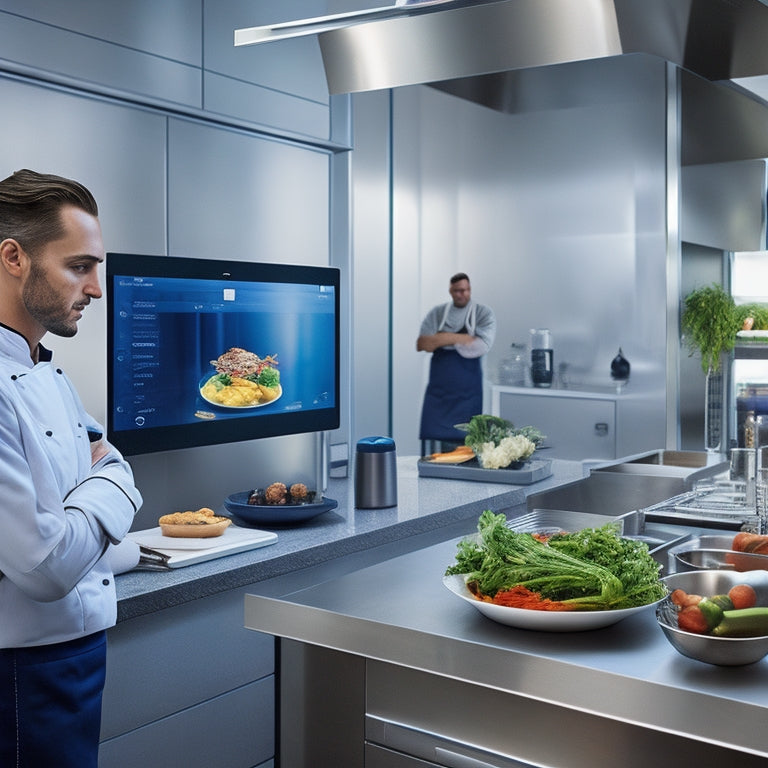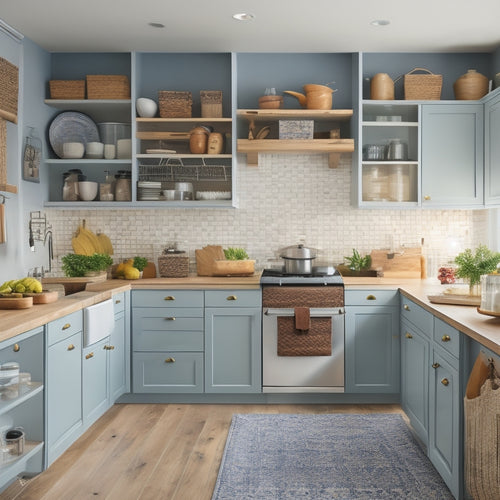
Streamline Commercial Kitchen Operations With Top Tools
Share
You're looking to optimize your commercial kitchen operations and take efficiency to the next level. Start by revamping your kitchen layout to maximize productivity, and implement a robust inventory management system to track supplies and negotiate better deals with suppliers. Streamline food prep with techniques like mise en place and cross-training staff. Effective shift scheduling, automated task management, and real-time inventory tracking will also boost productivity. Finally, implement data-driven performance metrics to identify areas for improvement. By mastering these top tools and strategies, you'll be well on your way to a more efficient, profitable kitchen - and there's even more to explore.
Key Takeaways
• Implement automated task management tools to streamline daily operations, delegate tasks with precision, and track efficiency in real-time.
• Utilize real-time inventory tracking systems to make data-driven decisions, optimize inventory levels, and reduce risk of human error.
• Leverage efficiency analysis tools to track performance metrics, identify trends, and make adjustments on the fly to optimize kitchen operations.
• Adopt sustainable kitchen practices, such as composting and food donation, to reduce environmental impact and improve business reputation.
• Invest in employee training and cross-training to increase flexibility, productivity, and efficiency, leading to improved overall commercial kitchen operations.
Optimizing Kitchen Layout and Design
When designing your commercial kitchen, you'll want to optimize the layout to maximize efficiency, reduce labor costs, and improve overall productivity. A well-planned kitchen layout can make all the difference in your operation's success.
To achieve an efficient workflow, consider the 'work triangle' concept, where your cooking, prep, and storage areas form the points of a triangle. This setup minimizes walking distances and reduces congestion.
Next, prioritize space utilization by allocating areas for specific tasks. Assign dedicated zones for food preparation, cooking, and cleaning to maintain a smooth workflow. Make sure that high-traffic areas, such as walkways and workstation aisles, are wide enough to accommodate staff comfortably.
Additionally, consider the 'clean line' concept, where dirty and clean areas are separated to prevent cross-contamination. By implementing these design principles, you'll be able to streamline your kitchen operations, reduce labor costs, and increase overall productivity.
Managing Inventory and Supplies
By accurately tracking and controlling your inventory and supplies, you can greatly reduce waste, minimize overstocking, and optimize your kitchen's operational efficiency. This means having a clear picture of what you need, when you need it, and how much you need. You can achieve this by implementing a robust inventory management system that allows you to monitor stock levels, track orders, and receive alerts when items are running low.
Effectively managing your inventory also enables you to negotiate better deals with suppliers. By knowing exactly what you need and when, you can negotiate bulk orders, discounts, and flexible payment terms. This can lead to significant cost savings and improved cash flow.
Additionally, regular equipment maintenance is essential to preventing breakdowns and reducing downtime. By scheduling regular maintenance checks, you can identify potential issues before they become major problems. This helps to minimize equipment failures, reduce repair costs, and make sure that your kitchen is always running at peak efficiency.
Streamlining Food Preparation Process
You can optimize your kitchen's productivity and efficiency by implementing a streamlined food preparation process that eliminates unnecessary steps, reduces waste, and maximizes output. By adopting time-saving food prep techniques, you can free up more time for creativity and innovation. Consider implementing efficient kitchen workflows, such as prep stations and assembly-line style production, to boost productivity.
| Time-Saving Techniques | Benefits |
|---|---|
| Mise en place | Reduces prep time, improves organization |
| Batch cooking | Saves time, reduces waste |
| Meal prep | Streamlines service, reduces stress |
| Cross-training | Increases flexibility, reduces labor costs |
To further optimize your food preparation process, focus on ingredient sourcing tips, such as buying in bulk and sourcing local ingredients. Implement inventory organization strategies, like categorizing and labeling ingredients, to reduce waste and improve efficiency. By streamlining your food preparation process, you can increase productivity, reduce waste, and maximize output, ultimately leading to a more profitable and successful kitchen operation.
Scheduling and Staff Management
Effective scheduling and staff management are crucial to maintaining a smooth kitchen operation, as they enable you to allocate resources efficiently and make sure that your team is working together seamlessly. By implementing effective shift scheduling, you can guarantee that you have the right people in the right place at the right time. This not only improves productivity but also reduces labor costs and minimizes overtime.
Furthermore, investing in employee training is essential to developing a skilled and efficient team. This will enable your staff to work independently, make informed decisions, and provide exceptional customer service.
Good time management is also key to keeping your kitchen running like clockwork. By prioritizing tasks, you can assure that everything gets done on time and to a high standard. Effective staff communication is also crucial to avoiding misunderstandings and ensuring that everyone is on the same page.
Recipe and Menu Engineering
Crafting recipes and menus that drive sales, reduce waste, and delight customers is essential to a commercial kitchen's success. You know that a well-engineered menu can make all the difference in your kitchen's profitability. To get it right, you'll need to conduct a thorough cost analysis to identify areas where you can optimize your menu for maximum profit.
This means evaluating the cost of each ingredient, labor, and overhead to determine which dishes are driving revenue and which ones are dragging you down.
When it comes to ingredient sourcing, you'll want to find suppliers that can provide you with high-quality ingredients at the best possible price. This might involve negotiating with vendors, sourcing locally, or exploring alternative options.
By streamlining your ingredient sourcing process, you can reduce waste, save time, and improve the overall quality of your dishes. With the right tools and strategies, you can create a menu that not only delights your customers but also drives your kitchen's success.
Automated Kitchen Task Management
By optimizing your menu and ingredient sourcing, you've laid the groundwork for a more efficient kitchen - now it's time to streamline daily operations with automated kitchen task management, ensuring that every station is running like a well-oiled machine.
Through kitchen automation, you can delegate tasks with precision and track efficiency in real-time. This means you can identify bottlenecks and make data-driven decisions to optimize your kitchen's workflow.
With automated task management, you can assign specific tasks to team members, set deadlines, and monitor progress. This streamlines communication, reduces errors, and frees up your time to focus on high-leverage tasks.
Real-time Inventory Tracking Systems
You can eliminate stockouts, overstocking, and waste by implementing a real-time inventory tracking system that provides accurate, up-to-the-minute information on your kitchen's ingredient levels and supplies. This technology integration enables you to make data-driven decisions, reducing the risk of human error and making sure you have the right ingredients at the right time. With real-time tracking, you can identify areas of waste and optimize your inventory levels, resulting in significant cost saving solutions. By adopting sustainable practices, you'll reduce your environmental footprint and enhance your kitchen's overall efficiency.
To get the most out of your inventory tracking system, employee training on how to use the technology effectively is crucial. This ensures that your team can accurately track inventory, receive alerts when items are running low, and automate orders when necessary.
Kitchen Waste Reduction Strategies
Your commercial kitchen generates a significant amount of waste daily, from food scraps to packaging materials, and implementing effective kitchen waste reduction strategies is crucial to minimizing your environmental footprint and maximizing your bottom line. By reducing food waste, you'll not only decrease your waste disposal costs but also contribute to sustainability initiatives.
Start by tracking your kitchen's waste output to identify areas for improvement. Implement a 'first-in, first-out' inventory system to reduce expired or spoiled ingredients. Train your staff to properly store and handle food to prevent spoilage. Consider composting or donating excess food to local charities or food banks.
Implementing these strategies won't only benefit the environment but also your business's reputation and bottom line. By taking control of kitchen waste, you'll be able to allocate resources more efficiently, reduce waste-related costs, and make a positive impact on your community.
Data-Driven Kitchen Performance Metrics
Key performance indicators (KPIs) such as food cost percentage, labor cost percentage, and inventory turnover rate provide valuable insights into your kitchen's operational efficiency. By tracking these metrics, you can identify areas that need improvement and make data-driven decisions to optimize your operations.
For instance, if your food cost percentage is higher than expected, you can analyze your inventory management and supplier contracts to find ways to reduce costs.
To take your performance monitoring to the next level, consider implementing an efficiency analysis tool that provides real-time data on your kitchen's performance. This will enable you to track KPIs in real-time, identify trends, and make adjustments on the fly.
With data-driven insights, you can streamline your kitchen operations, reduce waste, and increase profitability. By leveraging the power of data, you'll be able to make informed decisions that drive your business forward.
Frequently Asked Questions
How Can I Ensure Consistent Food Quality Across All My Locations?
You'll maintain consistent food quality across all locations by implementing rigorous quality control measures, enforcing strict food safety protocols, and conducting regular audits to guarantee uniform standards and exceptional taste in every dish you serve.
What Are the Most Common Kitchen Hazards and How Can I Mitigate Them?
You'll be alarmed to know that 57% of kitchen fires occur due to human error. To mitigate hazards, implement fire prevention measures, establish clear safety protocols, and guarantee staff wear proper footwear to prevent slip hazards.
Can I Use Technology to Reduce Labor Costs Without Sacrificing Quality?
You can leverage labor-saving technology to reduce costs without sacrificing quality by implementing automated systems for repetitive tasks, ensuring efficiency and cost reduction while maintaining quality control through data-driven insights and real-time monitoring.
How Do I Balance Customer Preferences With Menu Engineering Goals?
You cleverly juggle customer whims with menu engineering goals by embracing menu customization to boost satisfaction, while data analysis helps you pinpoint profitable options, striking a delicate balance that satisfies both palates and profit margins.
What Steps Can I Take to Maintain a Clean and Sanitary Kitchen Environment?
You maintain a clean and sanitary kitchen environment by prioritizing proper sanitization, scheduling regular equipment maintenance, and providing staff training on strict hygiene protocols to prevent contamination and maintain a safe space.
Related Posts
-

Mastering Kitchen Organization: 7 Expert Tips Inside
You're just a few simple strategies away from transforming your kitchen into a highly functional and efficient space ...
